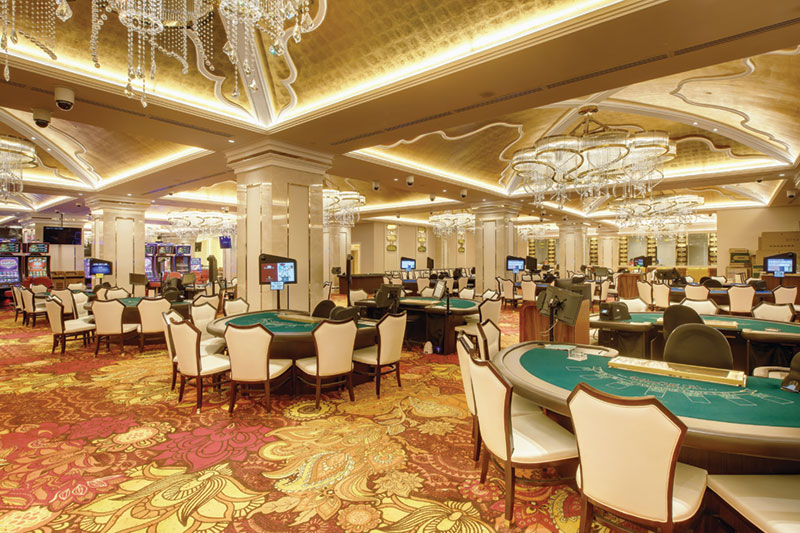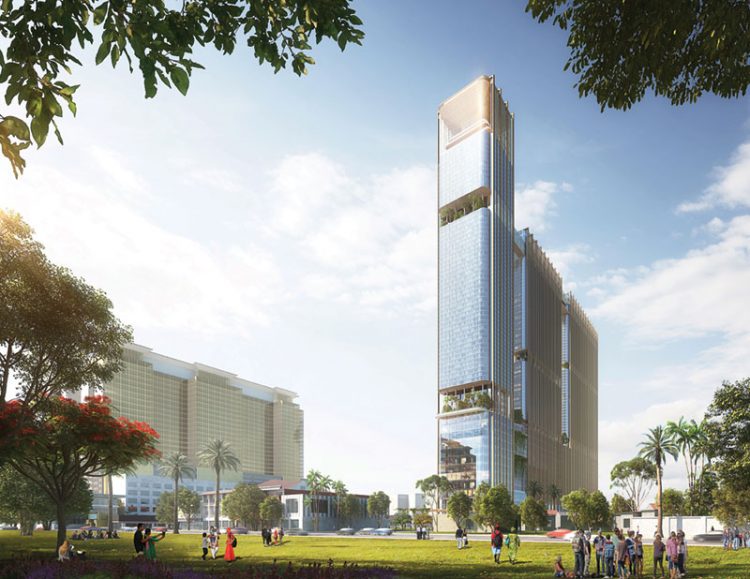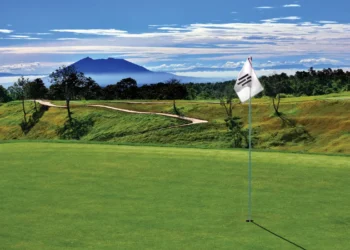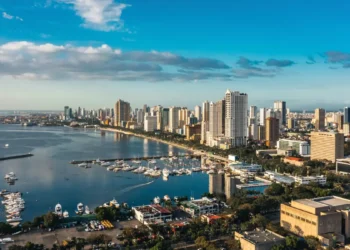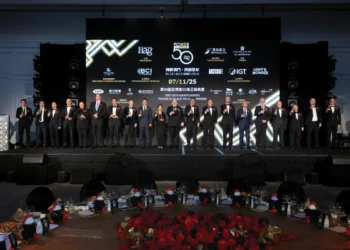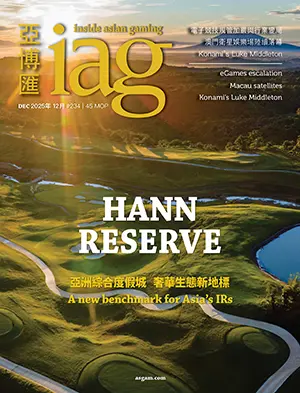Promising Cambodia’s tallest building, sky high swimming and landmark VIP play, NagaCorp remains committed to US$3.5 billion Naga3 despite COVID-19.
NagaCorp declares it is proceeding “full steam ahead” with Naga3, its bid to vault into the top tier of the world’s integrated resorts. Even with COVID-19 closing NagaWorld’s casino floor from 1 April through 7 July and likely breaking its streak of rising gaming revenue, EBITDA and profits, company officials remain committed to the US$3.5 billion integrated resort extension overlooking the Mekong River in Phnom Penh.
Information obtained by Inside Asian Gaming from NagaCorp executives requesting anonymity reveals key aspects of Naga3, though officials caution that many details are still subject to change as planning evolves. Renowned resort architects Steelman Partners, skyscraper experts Skidmore, Owings & Merrill, local architects and NagaCorp are working together to finalize the design.
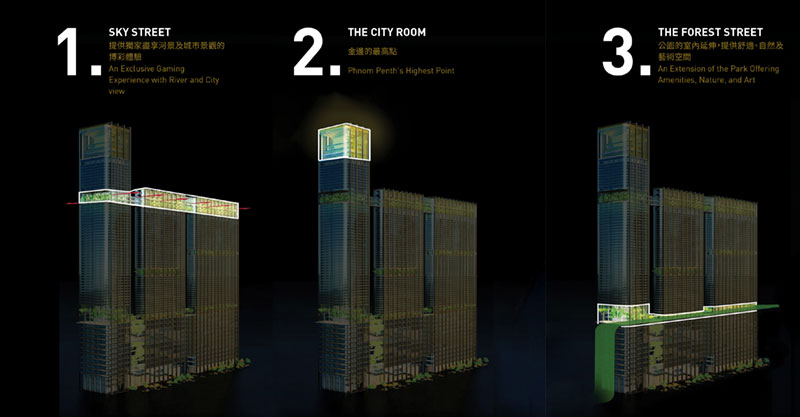 Upon completion scheduled for 2025, Naga3 will expand the NagaWorld complex total to 5,000 rooms, 1,300 gaming tables and 4,500 electronic gaming machines. Cambodia’s government is rewarding the investment with a 10 year extension of NagaCorp’s Phnom Penh monopoly to 2045; its gaming license runs to 2065.
Upon completion scheduled for 2025, Naga3 will expand the NagaWorld complex total to 5,000 rooms, 1,300 gaming tables and 4,500 electronic gaming machines. Cambodia’s government is rewarding the investment with a 10 year extension of NagaCorp’s Phnom Penh monopoly to 2045; its gaming license runs to 2065.
Some industry observers question the scale of Naga3, adding some 3,500 guest rooms, 700 tables and 2,000 gaming machines. Others doubt the wisdom of betting against Naga and its founder Chen Lip Keong, whose fortune of more than US$4 billion, according to Forbes, largely derives from owning nearly two-thirds of NagaCorp’s Hong Kong listed shares. Dr Chen – he earned a medical degree and briefly practiced before finding his calling in business – has this year added more than 28 million NagaCorp shares to his holding at a cost in excess of US$35 million, and he’s pledged to finance half of Naga3 from his own pocket.
“Cambodia remains one of the most ideal supplements to Macau for junkets operators and premium players, in terms of providing nearly all the elements that would be wishful thinking in Macau: much lower tax rates, a lenient regulatory environment, off Beijing’s radar – to some extent, but certainly ‘more off’ than Macau – cheaper labor cost but diligent workforce,” The Innovation Group’s Senior Vice President Michael Zhu says. “Additionally, NagaCorp has seamlessly avoided the pitfalls of online gambling [which Cambodia banned at China’s behest last year] and managed to extend its casino monopoly in Phnom Penh for another 10 years, all of which contributes to a pretty bright outlook for the company.”
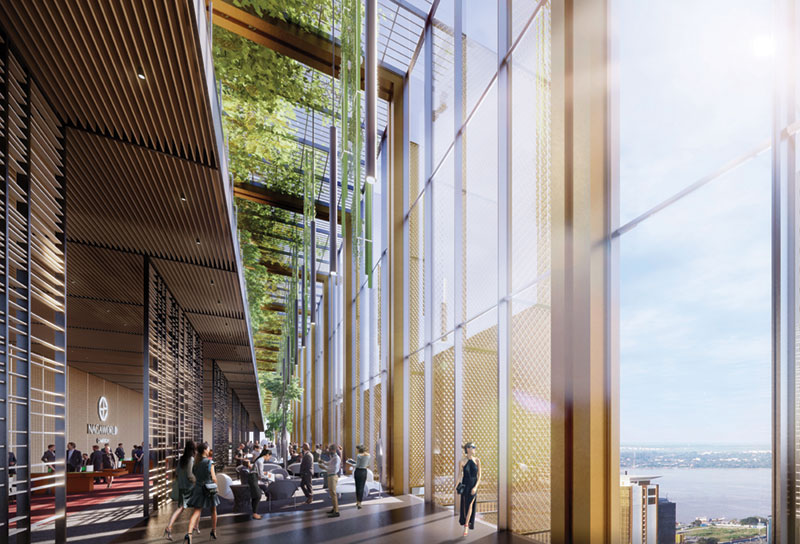
WINNING STREAK
From 2014 through the end of 2019, NagaCorp’s revenue more than quadrupled to US$1.76 billion, net profit more than tripled to US$521 million and EBITDA nearly quadrupled to US$671 million, a compound annual growth rate of more than 30% in each category. The biggest jumps have taken place since Naga2 opened in November 2017, with VIP revenue more than doubling through last year and mass GGR up 58%. Executives emphasize that mass play accounts for a majority of profits.
“Clearly, Naga2 has been a smashing success and has allowed the company to target not only higher-quality VIP players, but also the so-called premium mass segment that historically would patronize jurisdictions like Macau and Singapore,” Union Gaming Head of Institutional Research John DeCree says. “Naga3 will give the company a full complement of amenities that would allow it to appeal to all gaming customer segments, which coupled with the growing base of tourism, should result in Naga remaining the fastest growing gaming company globally.”
“Naga3 absolutely makes sense,” longtime Southeast Asia gaming executive Michael Gore says. “You can really go after a lot of premium ASEAN players. Unlike Sihanoukville, they don’t need to rely on China.”
Originally announced as five towers, the revised design for Naga3 sports a 75 story tower, the tallest in Cambodia, and two 61 story towers set in a public park covering the 1.2 hectare (3 acre) site. The new version creates a four level upper podium, dubbed Sky Street, linking the tops of the lower towers to the tallest one. Two levels will have VIP gaming with the rest reserved “as a huge recreational area, likened to the swimming pool areas of Marina Bay Sands Singapore, overlooking the romantic Mekong River and the entire city below,” according to NagaCorp documents.
The pool area will primarily occupy the rooftops of the lower towers and connect to the higher tower. The mix of outdoor and indoor recreational space depends on upcoming wind test results, company officials say, noting that flat topography around Phnom Penh increases high wind risks at elevation.
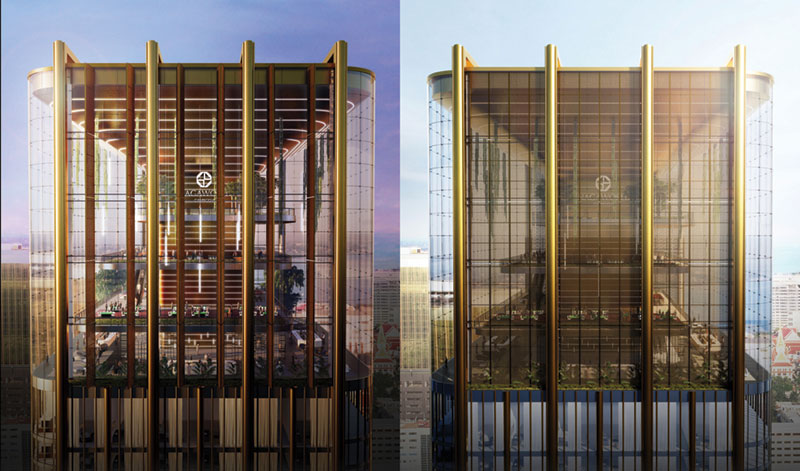
Four levels of VVIP gaming areas will crown the tallest tower. That area will be illuminated as a lantern, beams adjusted depending on the time of day. Given that Naga translates as gold in a number of Chinese dialects – in Hindu mythology, Naga is a serpent and it carries that meaning or “dragon” in many Southeast Asia languages – expect a gilded hue snaking across the skies above the Cambodian capital.
STREETSCAPE
The towers will be joined across a lower podium employing what NagaCorp terms a series of horizontal and vertical “streets” with a mix of dining, lifestyle and entertainment options in an “urban oasis” that “invites the local ecology inside.” Exterior capsule elevators will provide access to upper levels.
Naga3 will be linked to the existing complex by an extension of NagaCity Walk, the retail and entertainment area spanning 260 meters (853 feet) between Naga1 and Naga2. The projected additional distance to Naga3 is 480 meters. Naga says there will be underground and above ground transport between the nodes, possibly “a very futuristic transportation network,” according to Steelman Partners CEO Paul Steelman.
Financing for Naga3 follows the game plan for Naga2, where Dr Chen paid the US$392 million construction cost in exchange for shares. He has agreed to finance half of Naga3’s $3.5 billion cost in exchange for 1.14 billion company shares, a deal shareholders (excluding Dr Chen) approved nearly unanimously last August. Upon completion of the project, Dr Chen, NagaCorp’s CEO, will own 73% of the expanded company share base. Remaining development costs are expected to come from retained earnings, though last month Naga completed a US$350 million senior note offering, underscoring its ability to tap global debt markets.
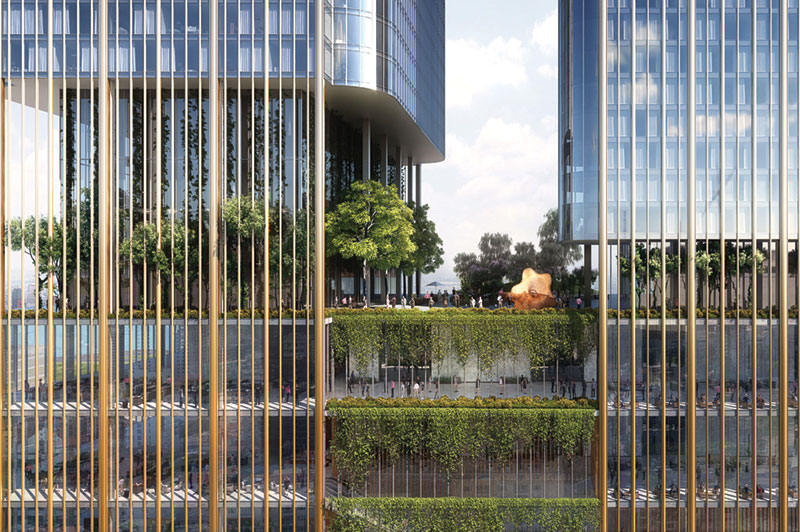
Departing from the first two NagaWorld blocks, Naga3 will feature international hotel brands. Current plans, awaiting contract signings, call for three widely recognized luxury marques, all new to Phnom Penh. NagaCorp officials confirm plans for international brands, “mainly to create awareness, especially from China,” according to one executive.
REVENUE GENERATING SPACE
What NagaCorp terms its “refined” Naga3 design cuts the number of hotel rooms by 1,200 from the original plan, while maintaining or even slightly increasing the 544,801 square meters (5.86 million square feet) of building area approved by shareholders. NagaCorp anticipates replacing guest rooms with more “revenue generating space,” including the Sky Street recreation and high-end gaming areas, though casino space will comprise no more than 7% of the IR’s built area.
Hong Kong Stock Exchange filings indicate Naga3 “will host a diverse mix of activities for families and guests – including hospitality, dining, conferencing and theme park areas,” but the company remains tight-lipped about specifics.
“I believe that the proposed uses in Naga 3 will fill the building with energy and income-producing spaces for all demographics,” Steelman, whose firm has been assigned interior architecture and design, says.
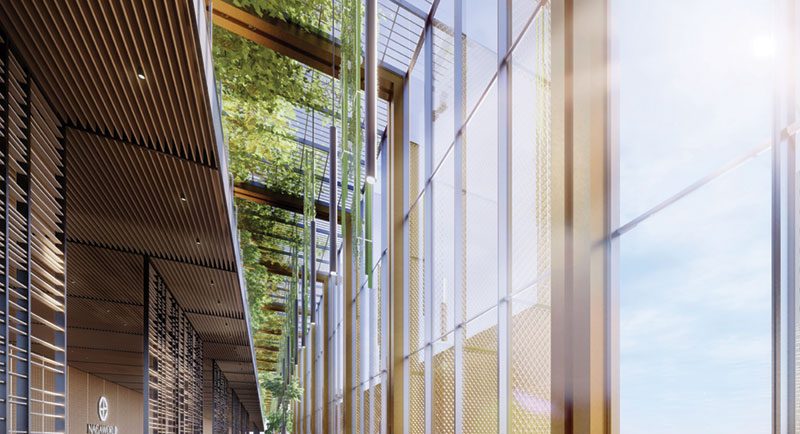 “Dr Chen has so many great ideas; he is an innovator in the integrated resort industry and Naga 3 will be his crown jewel,” Steelman adds. “In discussing Naga 3 with Dr Chen’s operational team, the built-up excitement reminds me of our first meetings in 1986 with Steve [Wynn] and the Mirage. Steve and Dr Chen dreamed and planned in their mind what a perfect resort could be for many years.”
“Dr Chen has so many great ideas; he is an innovator in the integrated resort industry and Naga 3 will be his crown jewel,” Steelman adds. “In discussing Naga 3 with Dr Chen’s operational team, the built-up excitement reminds me of our first meetings in 1986 with Steve [Wynn] and the Mirage. Steve and Dr Chen dreamed and planned in their mind what a perfect resort could be for many years.”
Naga3 presents significant development challenges. At 544,801 square meters, the new IR will have nearly as much gross floor area as Marina Bay Sands at 581,400 square meters, shoehorned into a 1.2 hectare site, compared with the 15.5 hectare plot for MBS.
“Naga 3 is a very large building uniquely designed to fit into the urban fabric of Phnom Penh,” Steelman, architect for Naga2, says. “It is designed on a relatively small parcel of property when compared to an integrated resort in Las Vegas or Macau. But its property is very large for being in the urban and commercial center of Cambodia.”
The architect compares Naga3’s vertical design to Galaxy Entertainment’s StarWorld on the Macau peninsula, one of the world’s highest grossing facilities in terms of built area.
VISIT OR STAY?
Design adjustments to Naga3 may also reflect changing realities in Phnom Penh. International visitors to Cambodia topped 6.6 million last year, a 6.6% increase, according to the Ministry of Tourism. Business related visits more than doubled to top 1.3 million, three-quarters of it from China, as Cambodia is seen as a key link in the Belt and Road Initiative, plus strong growth from Thailand, Indonesia and Dr Chen’s native Malaysia.
Accompanying visitor expansion is a growing expat business community in Phnom Penh of more than 100,000. What local media terms a burgeoning “Chinatown” has mushroomed on Naga’s doorstep. NagaCorp executives credit expats with fueling business since the casino reopened on 8 July with a lion dance and customers lining up to enter.
 NagaCorp officials emphasize NagaWorld was never fully closed. Cambodia has been relatively lightly touched by COVID-19, with just 171 cases reported as of mid-July, and some visitors have chosen to wait out the virus there rather than returning to harder hit countries. Cambodia’s borders also never closed, although visitor entry requires coronavirus test results, quarantine for 14 days and medical insurance coverage of at least US$50,000. Despite those barriers, visitors have trickled into the kingdom.
NagaCorp officials emphasize NagaWorld was never fully closed. Cambodia has been relatively lightly touched by COVID-19, with just 171 cases reported as of mid-July, and some visitors have chosen to wait out the virus there rather than returning to harder hit countries. Cambodia’s borders also never closed, although visitor entry requires coronavirus test results, quarantine for 14 days and medical insurance coverage of at least US$50,000. Despite those barriers, visitors have trickled into the kingdom.
To serve those groups, Naga’s hotel facilities remained open after the 1 April casino closure, with 10% to 20% hotel occupancy reported. Government mandated the closure of spas, bars, night clubs and karaoke, but Naga’s retail stores and some restaurants also remained open. Naga executives say they ran those skeleton operations with health and safety measures that gave the resort and Cambodia’s Ministry of Health a template for reopening the casino.
SAFETY FIRST
Under the reopening, all employees and guests are temperature screened and required to wear masks. Table games were initially restricted to VIP areas – open to all at VIP table limits – with a maximum of three seats per table and no standing play permitted. Mass gaming areas were slots only, with alternating positions disabled. On 18 July, Naga gained Ministry of Health permission to resume mass gaming table operations.
Restaurant tables stand 1.5 meters apart, with an overall capacity limit of 50% and no buffets. Disinfection takes place on a strict schedule, with sanitizer stations throughout the property. Naga reserves five isolation rooms for guests experiencing health issues, but they weren’t used during the first weeks of the reopening.
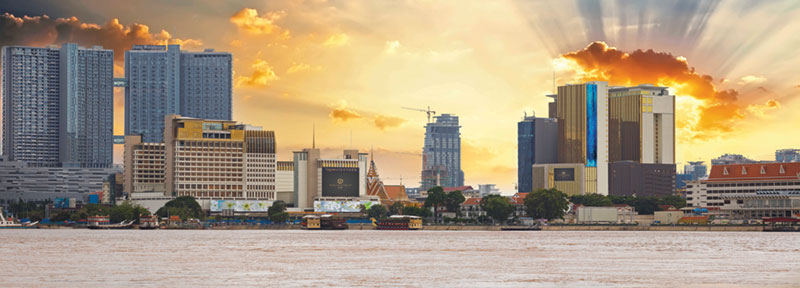
“As with all casinos, there is going to be a learning curve on how to optimize revenues. Naga has an astute operations and marketing team and I expect them to figure it out rather quickly,” Klebanow Consulting Principal Andrew Klebanow says.
“Naga is also fortunate in that the Mekong region has had a very low incidence of COVID-19. I expect the governments of Cambodia, Laos, Thailand, Vietnam and Malaysia will develop travel bubbles, where citizens from those nations can travel freely within that bubble. The bubble may also include provinces in China.”
As for Naga3, “COVID brought forward the changes we have anticipated for many years,” Steelman says. “In the past, all our designers had to focus on ‘touch-points’ – now, it’s the ‘non-touch points.’ Dr Chen is fully endorsing an integrated resort with the most innovative features to keep guests safe.”
Those features include room disinfection systems, doors and other room controls operated by guest mobile phones, voice operated elevators and, pending regulatory approval, a digital wallet system developed by Steelman Partners and affiliate Competition Interactive.
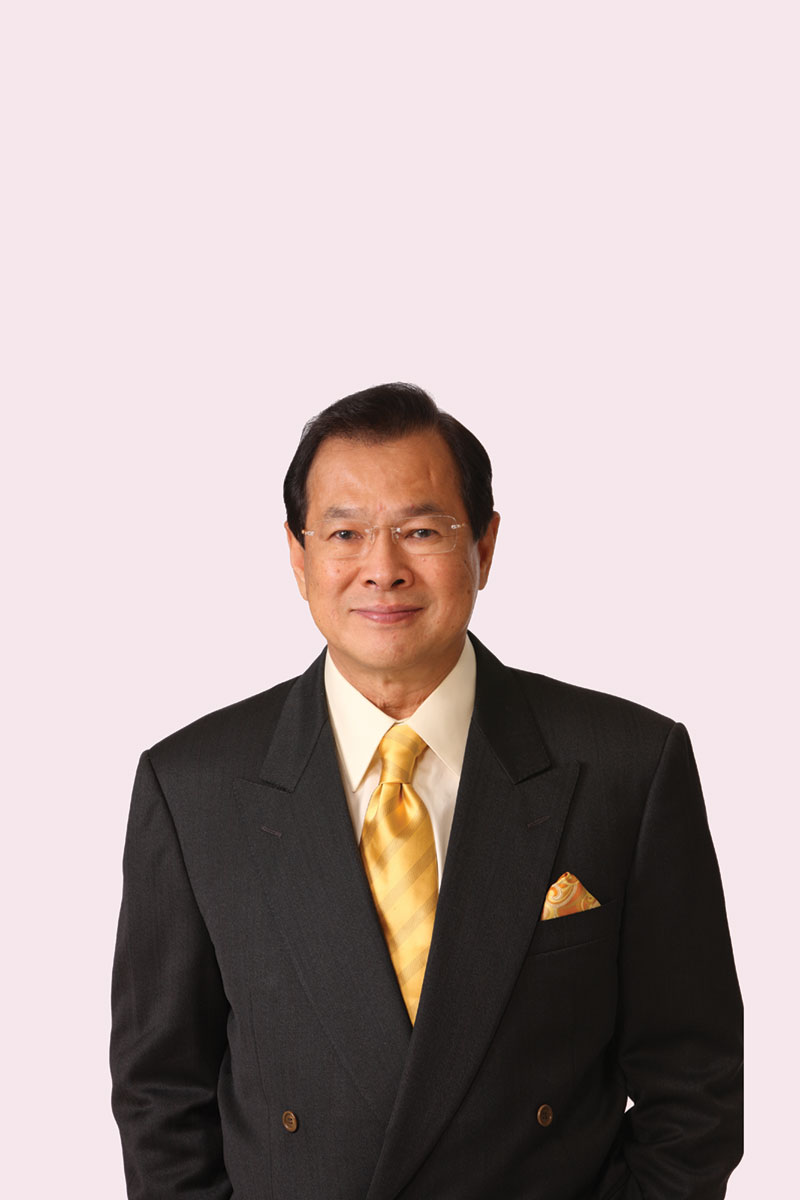
Site preparation for Naga3 continues despite coronavirus. With soil testing completed, the company is preparing tender documents for piling and basement construction, expected to begin later this year and run for 30 months. Requests for interest garnered responses from 18 construction contractors, NagaCorp says, including some Chinese state-owned firms.
“China and Cambodia are like a big brother/little brother relationship that will allow the Naga story to remain attractive,” Union Gaming’s DeCree says. “As Chinese – and non-Chinese – FDI continues to pour into Cambodia, there will be a continued positive effect of creating a ready-made base of expats that are hungry for IR-based activities and entertainment while also lifting the national economy and creating local wealth. Naga’s longer-dated exclusivity will allow it to maintain monopoly control and be the primary beneficiary from a gaming perspective in the whole of Indochina.”
